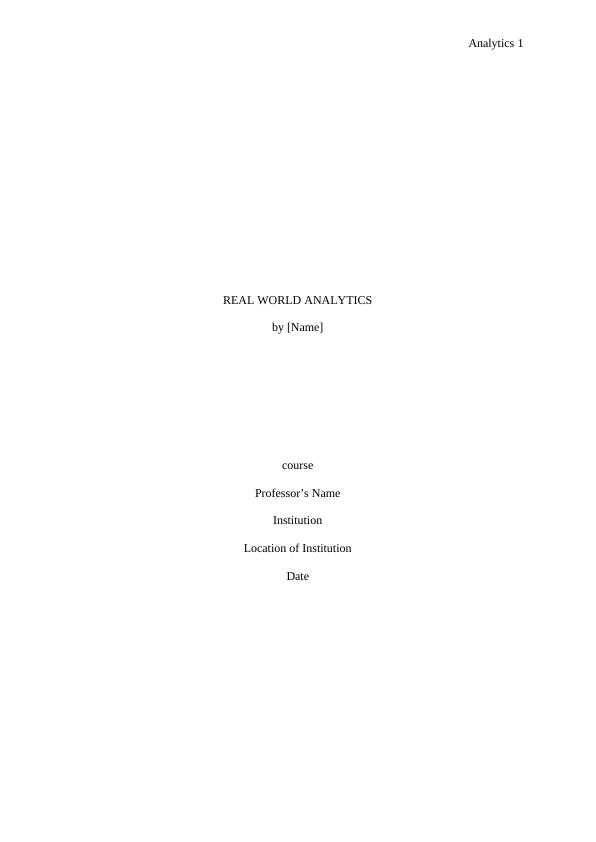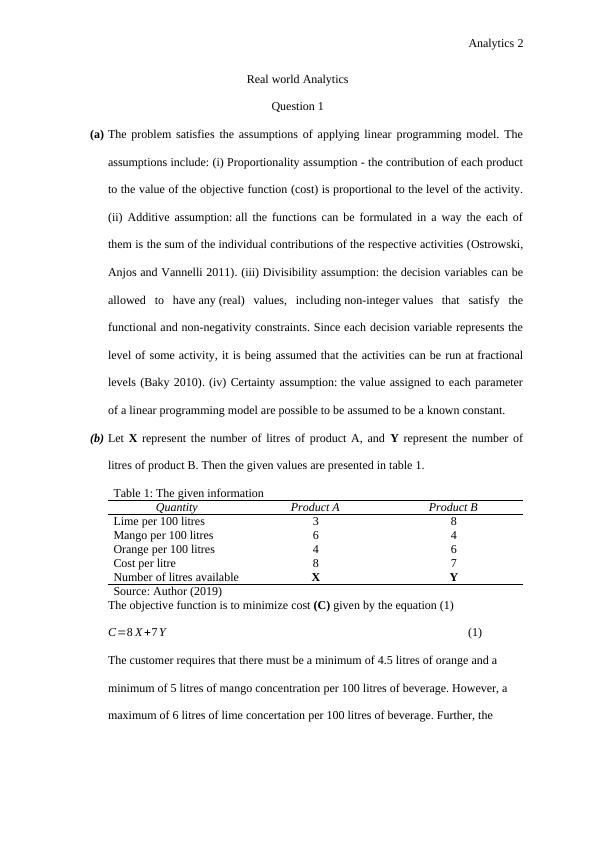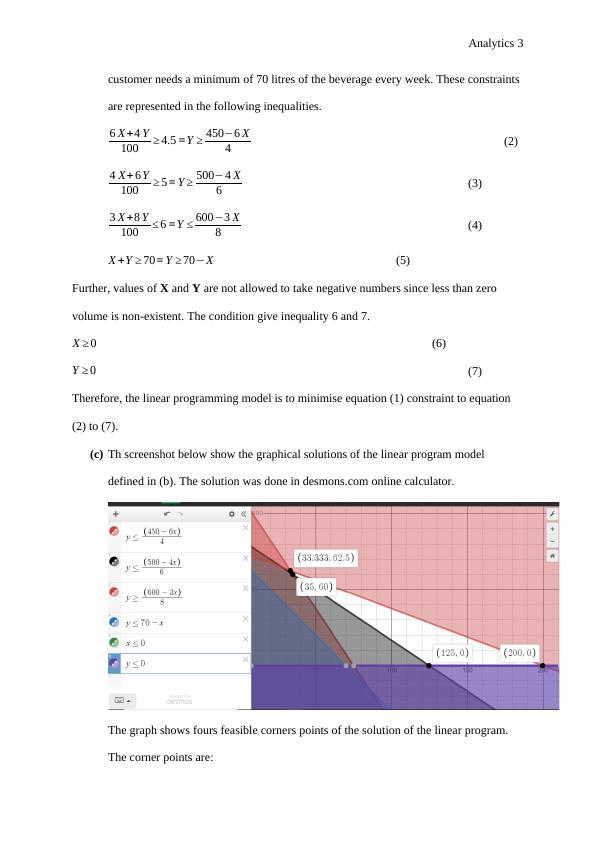Real World Analytics
Added on 2023-03-30
14 Pages2945 Words389 Views
Analytics 1
REAL WORLD ANALYTICS
by [Name]
course
Professor’s Name
Institution
Location of Institution
Date
REAL WORLD ANALYTICS
by [Name]
course
Professor’s Name
Institution
Location of Institution
Date

Analytics 2
Real world Analytics
Question 1
(a) The problem satisfies the assumptions of applying linear programming model. The
assumptions include: (i) Proportionality assumption - the contribution of each product
to the value of the objective function (cost) is proportional to the level of the activity.
(ii) Additive assumption: all the functions can be formulated in a way the each of
them is the sum of the individual contributions of the respective activities (Ostrowski,
Anjos and Vannelli 2011). (iii) Divisibility assumption: the decision variables can be
allowed to have any (real) values, including non-integer values that satisfy the
functional and non-negativity constraints. Since each decision variable represents the
level of some activity, it is being assumed that the activities can be run at fractional
levels (Baky 2010). (iv) Certainty assumption: the value assigned to each parameter
of a linear programming model are possible to be assumed to be a known constant.
(b) Let X represent the number of litres of product A, and Y represent the number of
litres of product B. Then the given values are presented in table 1.
Table 1: The given information
Quantity Product A Product B
Lime per 100 litres 3 8
Mango per 100 litres 6 4
Orange per 100 litres 4 6
Cost per litre 8 7
Number of litres available X Y
Source: Author (2019)
The objective function is to minimize cost (C) given by the equation (1)
C=8 X +7 Y (1)
The customer requires that there must be a minimum of 4.5 litres of orange and a
minimum of 5 litres of mango concentration per 100 litres of beverage. However, a
maximum of 6 litres of lime concertation per 100 litres of beverage. Further, the
Real world Analytics
Question 1
(a) The problem satisfies the assumptions of applying linear programming model. The
assumptions include: (i) Proportionality assumption - the contribution of each product
to the value of the objective function (cost) is proportional to the level of the activity.
(ii) Additive assumption: all the functions can be formulated in a way the each of
them is the sum of the individual contributions of the respective activities (Ostrowski,
Anjos and Vannelli 2011). (iii) Divisibility assumption: the decision variables can be
allowed to have any (real) values, including non-integer values that satisfy the
functional and non-negativity constraints. Since each decision variable represents the
level of some activity, it is being assumed that the activities can be run at fractional
levels (Baky 2010). (iv) Certainty assumption: the value assigned to each parameter
of a linear programming model are possible to be assumed to be a known constant.
(b) Let X represent the number of litres of product A, and Y represent the number of
litres of product B. Then the given values are presented in table 1.
Table 1: The given information
Quantity Product A Product B
Lime per 100 litres 3 8
Mango per 100 litres 6 4
Orange per 100 litres 4 6
Cost per litre 8 7
Number of litres available X Y
Source: Author (2019)
The objective function is to minimize cost (C) given by the equation (1)
C=8 X +7 Y (1)
The customer requires that there must be a minimum of 4.5 litres of orange and a
minimum of 5 litres of mango concentration per 100 litres of beverage. However, a
maximum of 6 litres of lime concertation per 100 litres of beverage. Further, the

Analytics 3
customer needs a minimum of 70 litres of the beverage every week. These constraints
are represented in the following inequalities.
6 X +4 Y
100 ≥ 4.5 ≡Y ≥ 450−6 X
4 (2)
4 X+ 6 Y
100 ≥ 5≡ Y ≥ 500−4 X
6 (3)
3 X +8 Y
100 ≤ 6 ≡Y ≤ 600−3 X
8 (4)
X +Y ≥ 70≡ Y ≥70−X (5)
Further, values of X and Y are not allowed to take negative numbers since less than zero
volume is non-existent. The condition give inequality 6 and 7.
X ≥ 0 (6)
Y ≥ 0 (7)
Therefore, the linear programming model is to minimise equation (1) constraint to equation
(2) to (7).
(c) Th screenshot below show the graphical solutions of the linear program model
defined in (b). The solution was done in desmons.com online calculator.
The graph shows fours feasible corners points of the solution of the linear program.
The corner points are:
customer needs a minimum of 70 litres of the beverage every week. These constraints
are represented in the following inequalities.
6 X +4 Y
100 ≥ 4.5 ≡Y ≥ 450−6 X
4 (2)
4 X+ 6 Y
100 ≥ 5≡ Y ≥ 500−4 X
6 (3)
3 X +8 Y
100 ≤ 6 ≡Y ≤ 600−3 X
8 (4)
X +Y ≥ 70≡ Y ≥70−X (5)
Further, values of X and Y are not allowed to take negative numbers since less than zero
volume is non-existent. The condition give inequality 6 and 7.
X ≥ 0 (6)
Y ≥ 0 (7)
Therefore, the linear programming model is to minimise equation (1) constraint to equation
(2) to (7).
(c) Th screenshot below show the graphical solutions of the linear program model
defined in (b). The solution was done in desmons.com online calculator.
The graph shows fours feasible corners points of the solution of the linear program.
The corner points are:

Analytics 4
First, (33.333, 62.5) implying X = 33.333, and Y = 62.5 substitute the values in
equation (1) as follows:
C=8 ( 33.333 ) +7 ( 62.5 ) =266.664+ 437.5=704.164
Second, (35, 60) implying X = 35, and Y = 60 substitute the values in equation (1) as
follows:
C=8 ( 35 ) +7 ( 60 ) =280+420=700
Third, (125, 0) implying X = 125, and Y = 0 substitute the values in equation (1) as
follows:
C=8 ( 125 ) +7 ( 0 ) =1,000
Finally, (200, 0) implying X = 200, and Y = 0 substitute the values in equation (1) as
follows:
C=8 ( 200 ) +7 ( 0 )=1,600
The objective was to minimize cost thus the lowest cost is at point value of X = 35,
and Y = 60. Further, check if the constraints are satisfied. All the constraints are
satisfied in the graph. The factory should use 35 litres of product A and 60 litres of
product B.
(d) In order to find the range of cost of product A that would make the least cost require
examining the two solutions that are closely related to each other (Coffrin and Van
Hentenryck 2014). The second step involves finding the cost of A that would make
the second minimum cost the least cost solution. The second lowest cost was obtained
when the value of X = 33.333 = 100
3 , and Y = 62.5. Therefore, the second least cost is
100
3 ( 8 ) +62.5 ( 7 ) = 4225
6 . Let Z be the cost of product A. Thus, to get the range of
values of Z solve the inequality
35 Z +60 ( 7 )> 100
3 Z +62.5(7) (8)
First, (33.333, 62.5) implying X = 33.333, and Y = 62.5 substitute the values in
equation (1) as follows:
C=8 ( 33.333 ) +7 ( 62.5 ) =266.664+ 437.5=704.164
Second, (35, 60) implying X = 35, and Y = 60 substitute the values in equation (1) as
follows:
C=8 ( 35 ) +7 ( 60 ) =280+420=700
Third, (125, 0) implying X = 125, and Y = 0 substitute the values in equation (1) as
follows:
C=8 ( 125 ) +7 ( 0 ) =1,000
Finally, (200, 0) implying X = 200, and Y = 0 substitute the values in equation (1) as
follows:
C=8 ( 200 ) +7 ( 0 )=1,600
The objective was to minimize cost thus the lowest cost is at point value of X = 35,
and Y = 60. Further, check if the constraints are satisfied. All the constraints are
satisfied in the graph. The factory should use 35 litres of product A and 60 litres of
product B.
(d) In order to find the range of cost of product A that would make the least cost require
examining the two solutions that are closely related to each other (Coffrin and Van
Hentenryck 2014). The second step involves finding the cost of A that would make
the second minimum cost the least cost solution. The second lowest cost was obtained
when the value of X = 33.333 = 100
3 , and Y = 62.5. Therefore, the second least cost is
100
3 ( 8 ) +62.5 ( 7 ) = 4225
6 . Let Z be the cost of product A. Thus, to get the range of
values of Z solve the inequality
35 Z +60 ( 7 )> 100
3 Z +62.5(7) (8)

End of preview
Want to access all the pages? Upload your documents or become a member.
Related Documents
Linear Programming, LP Problem, LP Function and Payoff Matrix in Game Theorylg...
|17
|2909
|404
Real World Analytics Question Answer 2022lg...
|8
|1741
|11
Assignment On Number Of Restrictions On The Amount Of Limelg...
|9
|2184
|13
Analytics Assignment Question 2022lg...
|9
|1996
|46
Real World Analytics 1lg...
|11
|1059
|480
Task Mathematics Problem Solving 2022lg...
|15
|3028
|9
